Hyperloop Accelerates Toward its Future
Although years from commercial viability, hyperloop development projects are well underway as engineers build on existing technologies.
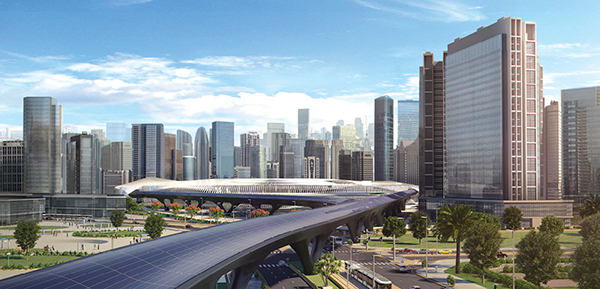
Hyperloop Transportation Technologies’ vision for a next-generation hyperloop station. Image courtesy of Hyperloop Transportation Technologies.
Latest News
December 1, 2018
The Quintero One, weighing in at 5 tons, measuring 105 feet long and made of a proprietary carbon fiber material branded Vibranium (in an apparent nod toward the fictional material of Marvel Comics), made its formal debut in October, providing the first glimpse at what a full-scale hyperloop passenger capsule will look like. DevLoop, a 500-meter full-scale hyperloop test site and track in the Nevada desert, is now operational, and student teams have wrapped up their third year of competing in SpaceX’s hyperloop pod challenge, setting new records for speed and acceleration.
In addition to steady engineering developments, the business of making the hyperloop next-generation transportation mode a reality is also well underway. The two primary players—Hyperloop Transportation Technologies and Virgin Hyperloop One—are knee deep in navigating the morass of the regulatory and safety landscape while also lobbying the U.S. government and foreign countries to fund feasibility studies and secure commitment for future hyperloop routes.
Most recently, global infrastructure giant Black & Veatch released the first U.S. independent feasibility study that found benefits for building a proposed route through the Interstate 70 corridor in Missouri, linking Kansas City and St. Louis—a win for Virgin Hyperloop One. The route, which aims to reduce travel time from 3.5 hours to 28 minutes, has the potential to boost ridership demand, reduce interstate accidents and lower fuel consumption—at a cost of around 40% less than high-speed rail infrastructure projects, the study found.
In addition to the Missouri study, Colorado is halfway through a feasibility evaluation for a proposed route, and both HTT and Virgin Hyperloop One have multiple feasibility studies and proposed commercial projects underway outside of the U.S., including those in the United Arab Emirates, Saudi Arabia, China, India and Ukraine.
“In the five years since we started, we’ve been working with companies and professionals that have the knowledge, intellectual property (IP), and technology to bring them all together rather than reinventing the wheel,” says HTT CEO Dirk Ahlborn. “We’ve been scouting the world for existing technology that fits the bill—our main goal is not to move at the speed of sound, but to build something that makes economic sense.”
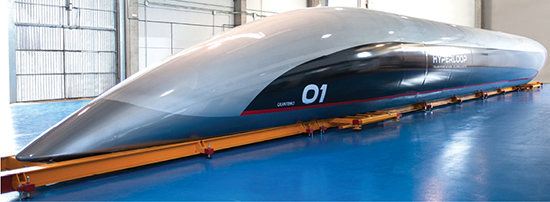
The Quintero One, HyperloopTT’s capsule, is made almost entirely out of a smart composite material. Image courtesy of Hyperloop Transportation Technologies.
The company showed off Quintero in October along with announcing a Q3 2019 target date to begin construction on a commercial hyperloop track in Abu Dhabi.
Building on Existing Foundations
Although confident in their progress to date, Ahlborn’s HTT and its primary competitor Virgin Hyperloop One are circumspect about the realities of fast-tracking an infrastructure project the magnitude of hyperloop. Born from a 57-page white paper released by tech titan and serial entrepreneur Elon Musk in 2013, the hyperloop (digitalengineering247.com/r/14834) was conceived as a pneumatic, tube-based transportation system that would be an alternative to high-speed rail systems.
The original concept, for a network of reduced pressure tubes that transport aerodynamically designed pods using magnetic levitation or air systems driven by linear induction motors and air compressors, hasn’t changed much since participants started early design work. Nor have the core engineering challenges shifted. They run the gamut from materials choices to optimizing the aerodynamics of the pod, to figuring out the best approach for combining magnetic levitation (maglev) with propulsion systems for sustained, accelerated speeds.
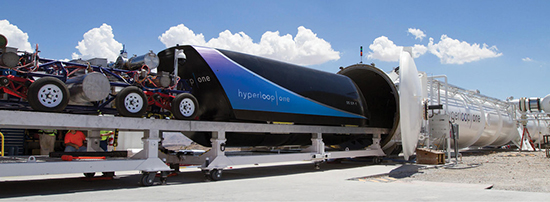
The XP-1 capsule is Virgin Hyperloop One’s first-generation capsule. Image courtesy of Virgin Hyperloop One.
What has changed, however, is that there are tangible results of ongoing engineering efforts, much of it built on the back of existing technology and systems. At its core, hyperloop is a civil infrastructure project similar to a bridge or underground tunnel while the pod is predicated on many of the principles of spacecraft or aircraft design, notes Kristen Hammer, manager of materials engineering at Virgin Hyperloop One, adding that the maglev and vacuum components of the system are also fairly well understood in engineering circles.
“Hyperloop is much more based in reality than people think once you break the problem down,” she explains. “Most of the systems are based on something that already exists—it’s putting them together in a unique way to do something different that is the key challenge.”
“I am very excited about AI and machine learning. I expect they will help my company sort through an effectively infinite set of simulation results to isolate those of greatest interest.”
— DE 2018 survey response
One of the engineering areas where Hammer is focused lies with how materials behave in the tube vacuum—for example, how a motor is able to withstand pressure or electrical components behave in the limited air environment. Even material choices for the tube itself are an important engineering study—the internal elements are required to handle temperature changes while the outside substance needs to hold up to external elements like corrosion or ambient heat generated by sunlight or the hyperloop system itself, she explains. “Whatever material you’re using has to be able to withstand a multitude of environments,” she explains.
To navigate these tube design challenges and more, Virgin Hyperloop One adheres to a rigorous process of “model it, simulate it and test it,” using a wide array of 3D simulation, optimization and system modeling tools. More recently, the team of 180 engineers started testing physical components at the DevLoop test site in the Nevada desert, Hammer says. Work is closely coordinated between the different engineering teams, which include structures, responsible for civil infrastructure like the columns and tubes; power electronics working on physical controls systems; levitation and motors; software engineering and manufacturing and testing.
As development work advances, 3D printing is playing a larger role in Virgin Hyperloop One’s engineering roadmap, especially aiding those components requiring a more organic shape, Hammer says. The company also set up the Metalworks tooling and fabrication site, which houses the engineers, machinists and welders working to support DevLoop.
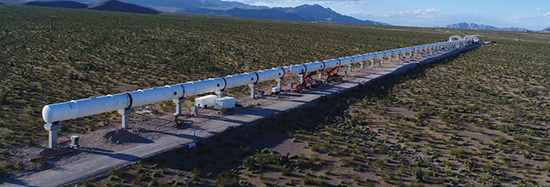
HTT, the other primary competitor in the hyperloop arena, has also hit some key development milestones. HTT got its start with an open-source development model, building up its own IP, but also tapping into a broad ecosystem of diverse engineers and other talent. Its Quintero One pod features the trademarked Vibranium skin comprised of carbon fiber material embedded with sensors, making it eight times stronger than aluminum and 10 times stronger than the alternative, the company claims. “The material is such that it is a sensor—it’s part of the fibers,” explains Ahlborn, adding that HTT partnered with Spanish artificial intelligence firm Airtificial on the smart material and capsule construction.
The benefit of the Vibranium smart material is intelligence and safety, he says, amplified by the fact that the pod capsule has a double layer (an inner and outer shell) for redundancy, which is a necessary safeguard when the goal is to transport people at speeds up to 700 mph. “Material sensing means we can measure even the smallest crack in the structure so we can take the capsule out of circulation quickly if need be,” he explains. “We want to do anything to keep passengers safe, and knowing what is happening is preventative.”
Another area where HTT has made progress is in magnetic levitation (maglev) technology. The company has an exclusive license for the Inductrack technology, created by researchers at the Lawrence Livermore National Laboratory in the 1990s. Inductrack is passive magnetic levitation technology that doesn’t require electromagnets or any power source to achieve levitation; the technique reduces friction and provides a better way to ensure safety in the event of a failure or power outage, Ahlborn says.
“Hyperloop is much more based in reality than people think once you break the problem down. Most of the systems are based on something that already exists—it’s putting them together in a unique way to do something different that is the key challenge.”
— Kristen Hammer, manager of materials engineering at Virgin Hyperloop One
The approach still requires linear motors for propulsion, and HTT is currently exploring the tradeoffs of designs that incorporate the propulsion capabilities into the capsule, which would make the track simpler, or keeping them trackside to save on onboard batteries and weight. “We’re looking at both approaches, depending on the route,” he says.
Along with simulation and optimization tools, HTT is using multiple collaborative platforms to facilitate work among its distributed design team. The firm also developed its own augmented reality (AR) tool for design reviews, which allows groups to view different files like 3D models and videos as part of their sessions, and virtual reality (VR) is enhancing collaboration. “It allows us to step inside the capsule and see what the space looks like in real time,” he explains. “That helps a lot because we don’t have to build something first to see what it looks like.”
Technology isn’t the biggest obstacle to hyperloop moving forward, Ahlborn says, but rather the regulatory frameworks, insurance and safety concerns, funding and government bureaucracy that comes along with any large-scale engineering and infrastructure project. “In the end, we know how to propel and levitate trains, we know how to create vacuums inside tubes, we have trains that can go 600 kilometers an hour,” he says. “The bigger problem is these are huge projects—it’s not just something where you can raise a couple of million dollars and sit in your garage and build something.”
Students Turbocharge Innovation
In addition to the two major commercial players, student teams from around the globe are doing their part to solve some of the tough engineering problems and advance hyperloop innovation. SpaceX, Musk’s aerospace and space transportation company, has hosted three Hyperloop Pod competitions, which challenge student teams to design and build the best high-speed pod or capsule.
The event is held at a 1.25-km Hyperloop test track at SpaceX headquarters in Hawthorne, CA. This year, 20 teams competed, with the Technical University of Munich (TUM) taking home the top prize for the third time thanks to its self-propelled 154-lb. carbon fiber pod powered with a 50kW electric motor and pneumatic friction brakes that reached top speeds of more than 284 mph. Prior competitions allowed pods to accelerate down the test track with help from a SpaceX vehicle as a pusher.
Given the competition, the TUM team’s key design challenge was to figure out the optimal power density that accounts for performance vs. weight. “We aimed to reduce mass in every possible way without having something disintegrate at high speed,” explains Gabriele Semino, TUM team’s project lead and team manager. “Each step of the concept where we reduced mass or increased power, the result was way better than we predicted possible.” For example, the second pod was 85 kilos with 50 kilowatts of power while the third pod was only 75 kilos with 240 kilowatts of power—a five-fold increase in power intensity, he says.
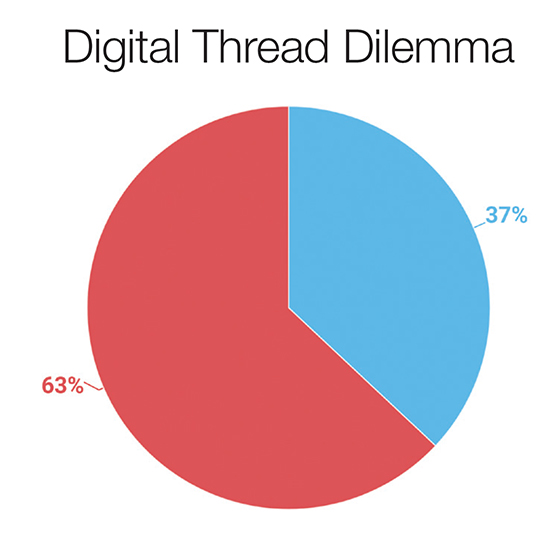
When asked what challenges or issues they face when developing a digital thread, respondents most often chose complexity of design and development (37%).
One of the design changes enabling this achievement was replacing one big motor with 12 smaller motors keyed to the stabilization wheels on the pod. The other big shift the third time around was conducting rigorous simulation and optimization to help achieve the better performance. “We took a pretty analytic approach to optimizing the design to withstand forces,” Semino says. “Simulation played a key role in that and with the reduction in weight.”
All this experience makes the student teams a likely feeder for future engineers staffing commercial hyperloop efforts. Semino, who is finishing up his studies, isn’t 100% sure he’ll end up at a hyperloop company, but he’s confident he’ll land in a firm pursuing transportation innovation. For now, the experience has provided an opportunity to do practical work and learn skills that just aren’t part of the mainstream engineering curriculum.
“We get to see the design process of a vehicle from beginning to end and that’s pretty rare,” he says. “It gets us motivated to think about the challenges and come up with new ideas and innovation so the moment we come out, we aren’t starting from scratch.”
Subscribe to our FREE magazine, FREE email newsletters or both!
Latest News
About the Author
Beth Stackpole is a contributing editor to Digital Engineering. Send e-mail about this article to [email protected].
Follow DE





